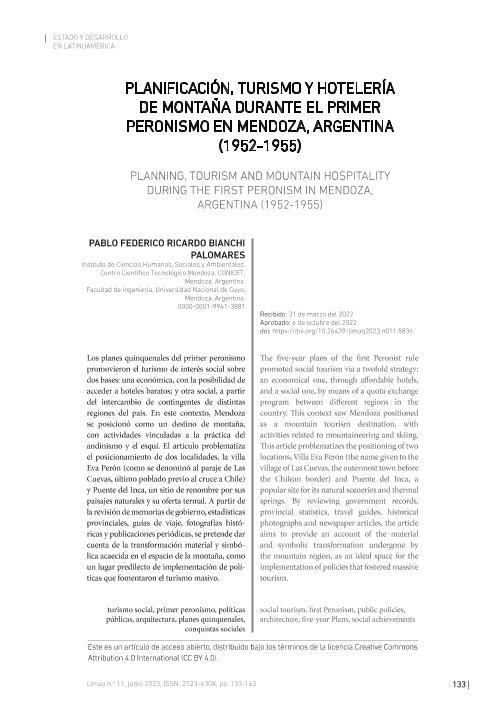Mostrar el registro sencillo del ítem
dc.contributor.author
Bianchi Palomares, Pablo Federico Ricardo

dc.date.available
2024-04-05T11:52:26Z
dc.date.issued
2023-06
dc.identifier.citation
Bianchi Palomares, Pablo Federico Ricardo; Planificación, turismo y hotelería de montaña durante el primer peronismo en Mendoza, Argentina (1952-1955); Universidad de Lima. Facultad de Arquitectura; Limaq; 011; 6-2023; 133-163
dc.identifier.issn
2410-6127
dc.identifier.uri
http://hdl.handle.net/11336/232060
dc.description.abstract
Los planes quinquenales del primer peronismo promovieron el turismo de interés social sobre dos bases: una económica, con la posibilidad de acceder a hoteles baratos; y otra social, a partir del intercambio de contingentes de distintas regiones del país. En este contexto, Mendoza se posicionó como un destino de montaña, con actividades vinculadas a la práctica del andinismo y el esquí. El artículo problematiza el posicionamiento de dos localidades, la villa Eva Perón (como se denominó al paraje de Las Cuevas, último poblado previo al cruce a Chile) y Puente del Inca, un sitio de renombre por sus paisajes naturales y su oferta termal. A partir de la revisión de memorias de gobierno, estadísticas provinciales, guías de viaje, fotografías históricas y publicaciones periódicas, se pretende dar cuenta de la transformación material y simbólica acaecida en el espacio de la montaña, como un lugar predilecto de implementación de políticas que fomentaron el turismo masivo.
dc.description.abstract
Te fve-year plans of the frst Peronist rule promoted social tourism via a twofold strategy: an economical one, through afordable hotels, and a social one, by means of a quota exchange program between diferent regions in the country. Tis context saw Mendoza positioned as a mountain tourism destination, with activities related to mountaineering and skiing. Tis article problematizes the positioning of two locations, Villa Eva Perón (the name given to the village of Las Cuevas, the outermost town before the Chilean border) and Puente del Inca, a popular site for its natural sceneries and thermal springs. By reviewing government records, provincial statistics, travel guides, historical photographs and newspaper articles, the article aims to provide an account of the material and symbolic transformation undergone by the mountain region, as an ideal space for the implementation of policies that fostered massive tourism.
dc.format
application/pdf
dc.language.iso
spa
dc.publisher
Universidad de Lima. Facultad de Arquitectura
dc.rights
info:eu-repo/semantics/openAccess
dc.rights.uri
https://creativecommons.org/licenses/by/2.5/ar/
dc.subject
TURISMO SOCIAL
dc.subject
PRIMER PERONISMO
dc.subject
POLÍTICAS PÚBLICAS
dc.subject
ARQUITECTURA
dc.subject.classification
Otras Humanidades

dc.subject.classification
Otras Humanidades

dc.subject.classification
HUMANIDADES

dc.title
Planificación, turismo y hotelería de montaña durante el primer peronismo en Mendoza, Argentina (1952-1955)
dc.type
info:eu-repo/semantics/article
dc.type
info:ar-repo/semantics/artículo
dc.type
info:eu-repo/semantics/publishedVersion
dc.date.updated
2024-04-05T11:04:56Z
dc.identifier.eissn
2523-630X
dc.journal.number
011
dc.journal.pagination
133-163
dc.journal.pais
Perú

dc.journal.ciudad
Lima
dc.description.fil
Fil: Bianchi Palomares, Pablo Federico Ricardo. Consejo Nacional de Investigaciones Científicas y Técnicas. Centro Científico Tecnológico Conicet - Mendoza. Instituto de Ciencias Humanas, Sociales y Ambientales; Argentina
dc.journal.title
Limaq
dc.relation.alternativeid
info:eu-repo/semantics/altIdentifier/url/https://revistas.ulima.edu.pe/index.php/Limaq/article/view/5836
dc.relation.alternativeid
info:eu-repo/semantics/altIdentifier/doi/http://dx.doi.org/10.26439/limaq2023.n011.5836
Archivos asociados
